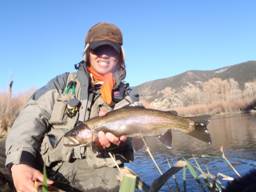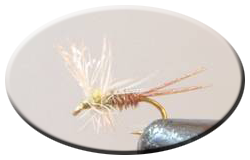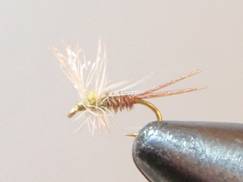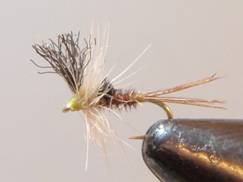PHEASANT TAIL MAYFLY CRIPPLE
Around Livingston, three Paradise Valley spring creeks, technical waters of Yellowstone Park, and Yellowstone River, all host various kinds of mayflies. Everyone has his/her own favorite time and species (my favorite is baetis hatches in spring and fall). For those favorite mayflies of ours (and of trout), there are tons of patterns ever invented and tested. Some make to the bins of local fly-shops and others remain in personal boxes, if not in the garbage bag.
Those surface patterns are typically called either crippled, emerging, impaired, fluttering, struggling, something like that. So I developed a cross-dresser. Tail and abdomen tied with pheasant tail fibers really mean emerging nymph. Then the front third represents crippled, struggling, drowned, or fluttering adults/emergers.
It works at spring creeks, Park waters, and even at mighty Yellowstone and Madison Rivers. With this fly, one can experiment his/her own presentation and the way to approach trout rather than tying on every fly you have in your vest onto your tippet all day long. After tests and trials, I decided to add ribbing wire as this fly has been chewed off easily by rising trout.
 How to Fish: On gin-clear flat waters of spring creeks, this should be fished down-&-cross with the right angle of presentation. On freestone waters like Madison and Yellowstone, this can be fished with upstream casting. Also it's very visible as a marker fly when trailing less visible dun patterns (such as dark CDC wing) or subsurface flies (emerging nymph patterns).
How to Fish: On gin-clear flat waters of spring creeks, this should be fished down-&-cross with the right angle of presentation. On freestone waters like Madison and Yellowstone, this can be fished with upstream casting. Also it's very visible as a marker fly when trailing less visible dun patterns (such as dark CDC wing) or subsurface flies (emerging nymph patterns).

Materials:
- Hook: Standard dry-fly hooks 14 for Heptagenia, 16 & 18 for PMD, 20 & 22 for BWO
- Thread: MFC Premium 8/0 Light Olive for Heptagenia & PMD, Olive for BWO
- Tail & Abdomen: Pheasant tail fibers
- Ribbing: Fine copper or gold wire
- Wing: Widow's Web fibers, black or white
- Hackle: Dun cock cape feather
- Body Dubbing: Superfine dub to match your imitation (built-up thread body for size 22).

Baetis size 20 & 22

PMD size 16 & 18
Step 1: Attach the thread to hook. Tie in a piece of wire then fibers of pheasant tail (number of fibers is depending on sizes of flies). Form a nice abdomen, reaching two-third of hook shank, tie off, and counter-wrap the wire.
Step 2: Tie in a wing material. [Both white and black work during various fishing condition]
Step 3: Tie in a dun hackle where wing is secured.
Step 4: Form a thorax behind the wing and just little a bit in front of the wing.
Step 5: Wrap the hackle once or twice both behind and in front of the wing (depending of sizes and your intension; sparse for spring creeks & full for rivers). Whip finish.
Step 6: Trim the wing in desired length. Also trim the bottom of hackle fibers flat.
Satoshi Yamamoto, https://leftyangler.blogspot.com, brought his passion for fly-fishing & fly-tying from Japan to Montana and became the first ever Japanese guide in Livingston/Bozeman area. He fishes big rivers like Madison & Yellowstone, spring creeks in Paradise Valley, and various waters in Yellowstone Park. Hence, with his Regal Vise at the bench, his fly tying interests vary from tiny midges to 5-inch streamers and anything in between. Once his ideas are combined he goes out for experiments at those near-by waters. Satoshi submits his innovative patterns to Montana Fly Company (www.montanafly.com). Also, he has a Masters' in Animal Science from Montana State University and has been a professional cattle breeder when not guiding.
For more great info, check out:
Beginning Fly Tying | Intermediate Fly Tying | Advanced Fly Tying.
